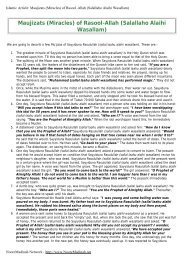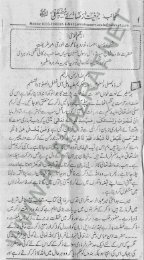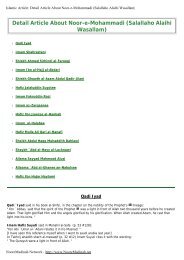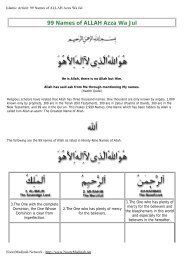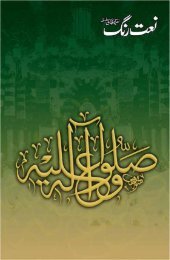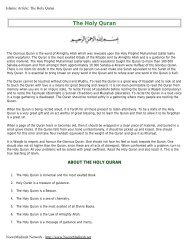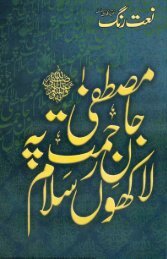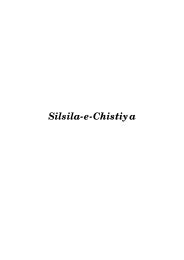Download PDF - Noore Madinah Network
Download PDF - Noore Madinah Network
Download PDF - Noore Madinah Network
Create successful ePaper yourself
Turn your PDF publications into a flip-book with our unique Google optimized e-Paper software.
Islamic Article: Islamic Dressing Code of Conduct<br />
Islamic Dressing & Code of Conduct<br />
THE HOLY PROPHET'S DRESSING<br />
A. Colour of Dress: The colours of preference of Rasoolullah (sallal laahu alaihi wasallam) were first white, and<br />
then, green.<br />
B. Shirts (Kamees) and Robes: Rasoolullah (sallal laahu alaihi wasallam) used a single long robe and<br />
recommended its use for others; as it covers the major portions of the body.<br />
C. Trousers: The Holy Prophet (sallal laahu alaihi wasallam) recommended the use of trousers to length of half of<br />
the lower portion of the leg. It may however be lengthened above the ankle.<br />
D. Turban and cap: There are a few Traditions (Hadith) discussing the use of the cap and advocating that it<br />
should be generally, round and even at the top.<br />
COLOUR OF DRESS<br />
It is stated in "Sunan ibn Majah", "Tirmizi Shareef", "Nisa'i Shareef" and "Musnad Imam Ahmed" that Samorah<br />
reported that the Prophet of Allah (sallal laahu alaihi wasallam) said, "Put on white dress because it is most pure and<br />
pleasant; and use it as a Kaffan for your dead bodies."<br />
The following Ahadith have been recorded in both "Bukhari Shareef" and "Muslims Shareef":-<br />
a. Hazrat Anas (radi Allahu anhu) reported that the dress most pleasing to the Prophet (sallal laahu alaihi<br />
wasallam) for use was green coloured robe.<br />
b. Hazrat Mughirah bin Sha'bah (radi Allahu anhu) reported that the Prophet (sallal laahu alaihi wasallam) put on a<br />
robe with tight sleeves.<br />
c. Hazrat Abu Burdah (radi Allahu anhu) reported, Sayyidah Aisha (radi Allahu anha) brought out to us a patched<br />
garment and a coarse trouser. She said: "The soul of the Messenger of Allah was taken in this two."<br />
d. Hazrat Abu Hurairah (radi Allahu anhu) reported that the Messenger of Allah (sallal laahu alaihi wasallam) said,<br />
"Allah will not look, on the Resurrection Day to one who lets loose his trousers out of vanity (pride)."<br />
e. Bukhari has reported that Abu Hurairah (radi Allahu anhu) stated that the Messenger of Allah (sallal laahu alaihi<br />
wasallam) said, "Whatever flows of the trouser below the ankles will be in the fire."<br />
f. Abu Dawood and Ibn Majah have recorded a Hadith from Hazrat Abu Sa'eed Al Khudri (radi Allahu anhu) who<br />
stated that, "I heard the Prophet (sallal laahu alaihi wasallam) say, 'The trouser of a believer is up to half his<br />
hind legs. There is no sin for what is above the ankles. What is below that is in the fire. (This he said thrice).<br />
On the Resurrection Day, Allah shall not look to one who allows his trouser to flow out of vanity.'"<br />
g. Ibn Omar (radi Allahu anhu) reported that the Messenger of Allah (sallal laahu alaihi wasallam) said, "Whoever<br />
puts on a robe of fame in this world, Allah will dress him with the robe of disgrace on the Resurrection Day."<br />
h. Tirmizi recorded a Hadith by Ibn-e-Omar (radi Allahu anhu) who stated that whenever the Messenger of Allah<br />
(sallal laahu alaihi wasallam) put on a turban, he allowed his turban to flow between his shoulders.<br />
<strong>Noore</strong><strong>Madinah</strong> <strong>Network</strong> - http://www.<strong>Noore</strong><strong>Madinah</strong>.net
Islamic Article: Islamic Dressing Code of Conduct<br />
i. Tirmizi has also recorded a Hadith by Rukanah (radi Allahu anhu) who stated that the Messenger of Allah (sallal<br />
laahu alaihi wasallam) said, "The distinction between us and the polytheists is turbans over our caps."<br />
USE OF SOCKS AND SHOES<br />
The Holy Prophet Muhammad (sallal laahu alaihi wasallam) used to wear shoes (sandals) that had two straps. He<br />
never wore shoes (sandals) that had fur. There has been recorded in the Ahadith that the Holy Prophet (sallal laahu<br />
alaihi wasallam) had used socks of various types.<br />
The Sunnat method of wearing socks and shoes is that the right foot must be worn first and then the left foot. In<br />
removing the socks and shoes the order is reversed; the left foot must be done first and then the right foot.<br />
In the colder climates, Muslims were used to wearing leather type of socks. Muslims using this leather type of socks<br />
are granted the concession whilst making Wuzu of making Masah over these socks instead of washing the feet for<br />
Wuzu. The concession is that a traveller may make Masah over the leather socks for a period of three nights and<br />
three days whilst the resident of a permanent home may do so for only one day and one night.<br />
The following are some of the Ahadith that relate to the use of socks and shoes:-<br />
l Hazrat Anas (radi Allahu anhu) reported that the shoe of the Prophet (sallal laahu alaihi wasallam) had two<br />
laces. (Bukhari)<br />
l Hazrat Abu Hurairah (radi Allahu anhu) reported that the Messenger of Allah said: When any of you puts on his<br />
shoes, let him begin from right-side; and when he puts off, let him begin from the left-side, so that the rightside<br />
will be the first of them for putting on shoe and the last of them for putting it off. (Agreed)<br />
l Hazrat Abu Hurairah (radi Allahu anhu) reported that the Messenger of Allah said: None of you shall walk with<br />
one shoe; let them both be bare, or let them both be shoed. (Agreed)<br />
l Hazrat Jaber (radi Allahu anhu) reported that the Messenger of Allah forbade a man's putting on shoes<br />
standing. (Abu Dawud, Tirmidhi)<br />
l Hazrat Ibn Abbas (radi Allahu anhu) reported: It is Sunnat for a man to put off his shoes when he sits down,<br />
and place them by his side. (Abu Dawud)<br />
l Hazrat Ibn Boraidah (radi Allahu anhu) reported from her father that Negus had presented the Prophet (sallal<br />
laahu alaihi wasallam) two plain black socks which he afterwards put on. (Ibn Majah, Tirmidhi)<br />
THE HAT<br />
The wearing of the hat is the pride, the sign, the light and the honour of a Muslim. It is also the Sunnah of the<br />
Prophet (sallal laahu alaihi wasallam).<br />
The Prophet (sallal laahu alaihi wasallam) said: "The difference between us and the Mushrikeen is that we wear our<br />
Turbans on our hats, and they wear it without a hat". The great Jurists have stated that it is Sunnah for men to wear<br />
the turban during Salaah, since the reward for this is more. This shows that the hat should be worn, because if the<br />
turban is worn, it must be worn on a hat. It is in "Fatawa Alamgeeri", page 291, that the wearing of the hat is a<br />
Sunnah. It is in all the famous books of Fiqh that to abstain from wearing the hat without reason is Makrooh-e-<br />
Tanzeehi, and if the hat falls in Salaah, then to put it on is better. This should, however, not be Fel-e-Katheer (where<br />
is falls continuously).<br />
It is also disliked to read Namaaz or make Tilaawat of the Quran Shareef without the hat. It is also Makrooh to go into<br />
the toilet without a hat. Some people say that if the hat was so necessary, then why is it during Hajj one does not use<br />
it in the Kaaba. Such persons should know that there are various other things that you are not allowed to do in the<br />
<strong>Noore</strong><strong>Madinah</strong> <strong>Network</strong> - http://www.<strong>Noore</strong><strong>Madinah</strong>.net
Islamic Article: Islamic Dressing Code of Conduct<br />
Kaaba that you could do anywhere else. Some of them are stated below:-<br />
1. To make Raml (walk proudly) during Tawaaf in Hajj is allowed. Will you do this anywhere else, whereas the<br />
Quran has stated: "Do not walk on the Earth with pride"?<br />
2. To avoid the use of soaps and perfumes in Ihraam is essential. Does this mean that it should not be used at all<br />
during other times, even though the Prophet (sallal laahu alaihi wasallam) used 'Ittar and commanded it's use<br />
on Jummah and Eid?<br />
3. During the days of Hajj, we are not allowed to use sewn clothes. Does this mean that you should always wear<br />
unsewn clothes, even though it has been stated that the humans are decorated by their clothes?<br />
4. During Hajj, one is allowed to pass in front of a Namaazi. Will you always do this, even though it is not allowed<br />
in another time? Has it not been stated that if one were to know the punishment for passing in front of a<br />
Namaazi, then even if he had to wait all his life for the Namaazi to turn Salaam, he would do so?<br />
5. During Hajj, you are allowed to read Zohr and Asr in Arafaat in the time of Asr, and Maghrib and Esha in the<br />
time of Esha in Muzdalifa. Will you perform your Namaaz in this way even if you are in your own country?<br />
Muslims! Respect the hat and use it in Ibaadat. May Allah have mercy on us and save us from the ways of others.<br />
THE BEARD AND THE MOUSTACHE<br />
The beard is the Sunnah of Ambiya, the sign of Islam, the recognition of a Muslim and the beauty to the face of a<br />
man. The keeping of the beard keeps one away from various sins. To keep the beard one fist length is Sunnah and to<br />
trim it less than this or remove it completely is Haraam and a sin. To allow a person, whose beard is trimmed shorter<br />
than the prescribed length, or one who shaves of his beard, to be an Imaam is not allowed and a sin. Hufaaz,<br />
especially those who keep the beard in Ramadaan and shave it off afterwards, should ponder over this. Namaaz of<br />
any type behind such a person is not allowed.<br />
To mock the beard can also lead to Kuffar. To shave off the beard and lengthen the moustache is the way of the<br />
Kufaar, Mushrikeen, Majoosi and Christians. It is for the reason that the Prophet (sallal laahu alaihi wasallam)<br />
commanded us to act against this by lengthening our beards and trimming our moustache. The moustache gives off a<br />
certain secretion which is not healthy, and if it were to go into food and water, then it would be unhealthy. Therefore,<br />
we should trim the moustache and not shave it off completely. To shave the beard weakens the manhood. To dye the<br />
beard and hair with black dye for man is prohibited by authentic Ahadith. Some ladies also get beards or moustache.<br />
They are allowed to remove this.<br />
SALAAM: GREETING<br />
CODE OF CONDUCT<br />
SALAAM AND MUSAAFHA (SHAKING HANDS)<br />
It has been stated in the fifth part of the Holy Quran: "If someone sends Salaam upon you in good words, then you<br />
too must send Salaam upon them in better words or the same". This shows the importance of making Salaam in<br />
Islam.<br />
Salaam is a way of respect. It is a beautiful greeting, a means of showing love and gentleness, and a means of<br />
creating a bond of brotherhood. Salaam takes away jealousy, hatred and enmity. To be the first to make Salaam to a<br />
person is a means of great mercy and reward. Who better to explain the excellence of Salaam than the Holy Prophet<br />
Muhammad (sallal laahu alaihi wasallam)? He said: "When two Muslims meet one another, then they should first<br />
make Salaam. If they are then separated by a tree, pillar or wall, on seeing one another again, they should make<br />
Salaam".<br />
<strong>Noore</strong><strong>Madinah</strong> <strong>Network</strong> - http://www.<strong>Noore</strong><strong>Madinah</strong>.net
Islamic Article: Islamic Dressing Code of Conduct<br />
The first Salaam was made by Hazrat Adam (alaihis salaam) to the Angels showing that Salaam is a Sunnat of the<br />
Nabis. The beauty of Salaam is that when one person makes Salaam to the next, he says, "As Salaamu Alaikum" (May<br />
all kinds of peace be upon you). In this way he is making Du'a for the person's health, welfare, prosperity and all<br />
good things. The person who returns the Salaam, says, "Wa Alaikumus Salaam" (And the same upon You), meaning<br />
that he returns the same Du'a and more to you.<br />
Salaam is also a means of promise and bondship. When one Muslim makes Salaam to the other, then he is assuring<br />
him that he is now safe from him and he will not be the cause of any pain or loss to him in any way. The person who<br />
replies to the Salaam also now makes the pledge of assurity.<br />
The answer to Salaam must be given immediately as it is Waajib to do so and a sin to delay. To make Salaam during<br />
Azaan, Iqaamat Namaaz, Khutba, when a person is in the Istinja, or if he or she is having a meal, is not allowed. To<br />
make Salaam by lifting the fingers of the palm is not allowed as this is the manner of the Christians and Jews. It is<br />
also Haraam to make Salaam to a Kaafir, Mushrik, Bud- Mazhab or Gustakh-e-Rasool (one who insults the station of<br />
Prophethood).<br />
One should make Salaam when entering another persons home. When entering one's own home, one should make<br />
Salaam to one's parents, wife, brothers, sisters and children. When entering an empty house, on should say: "As<br />
Salaamu Alaika Ayuhan Nabiyu wa Rahmatullahi Wa Barakaatuhu, Was Salaamu Alaina Wa Alaa Ibaadallahis<br />
Saaliheen".<br />
When entering the Musjid, one should say: "Bismillahi Was Salaamu ala Rasoolullahi".<br />
When going to the grave of a Muslim, say at least this: "As Salaamu Alaikum Ya Ahlil Quboor Yaghfirullah lana wa<br />
lakum Wa Inna Insha Allahi Bikum Laahiqoon".<br />
When visiting the Roza-e-Anwar of Rasoolullah (sallal laahu alaihi wasallam) one should say: "As Salaatu Was<br />
Salaamu Alaika Ya Rasoolallah, As Salaatu Was Salaamu Alaika Ya Habeeballah, As Salaatu Was Salaamu Alaika Ya<br />
Rahmatal Lil Alameen Wa Alaa aalika wa Ashaabika Ya Shafi al Muznibeen".<br />
MUSAAFHA: SHAKING HANDS -<br />
Like Salaam, their are many beauties of Musaafa that have been quoted in the Ahadith. It is proven to be a<br />
continuous Sunnah of the Prophet (sallal laahu alaihi wasallam).<br />
It has been stated in the Hadith that when a Muslim makes Musaafa with another Muslim, then by the mere motion of<br />
the hands, all the sins fall thereof. The Prophet (sallal laahu alaihi wasallam) has stated that when two Muslims make<br />
Musaafa with one another, then even before separating, they are forgiven. The Prophet (sallal laahu alaihi wasallam)<br />
has stated that when two Muslims make Musaafa by the shaking of the hands, their sins fall off in such a manner as<br />
the leaves of a tree fall off during a hurricane, even though they are equivalent to the foam on the sea.<br />
When making Musaafa, it is Sunnah to do so with both hands. It is permissible to make Salaam and Musaafa after<br />
every Namaaz as it is a means of Barakah.<br />
For males to shake hands with na-Mahram ladies is not permissable.<br />
MUAANIQA: TO MEET SHOULDER TO SHOULDER<br />
To meet one another, chest to chest, heart to heart, neck to neck and shoulder to shoulder is called "Muaaniqa". This<br />
is a sign of love and friendship. On many occasions, the Holy Prophet (sallal laahu alaihi wasallam) held the Sahaba to<br />
his blessed chest and on various occasions, the Sahaaba made Muaaniqa with the Prophet (sallal laahu alaihi<br />
wasallam).<br />
BOSA-E-MUHABAT: TO KISS OUT OF LOVE<br />
<strong>Noore</strong><strong>Madinah</strong> <strong>Network</strong> - http://www.<strong>Noore</strong><strong>Madinah</strong>.net
Islamic Article: Islamic Dressing Code of Conduct<br />
To kiss the mother, father, Peer, Ustaad, brothers, sisters, wife or children, hand, feet, forehead or cheek out of love<br />
and affection is totally permissible and a way of showing love and reverence.<br />
Dear Muslims, make Salaam in the manner prescribed to you when meeting one another, rather than saying,<br />
"Howzit", "Namaste", "Good Morning", "Good-bye" or "Good night", etc. The Muslim method of greeting is the best<br />
and most kind way of greeting. May Allah protect us from following the ways of non-Muslims. Ameen.<br />
<strong>Noore</strong><strong>Madinah</strong> <strong>Network</strong> - http://www.<strong>Noore</strong><strong>Madinah</strong>.net<br />
Copyright (c) 1997 - 2005 by<br />
<strong>Noore</strong><strong>Madinah</strong> <strong>Network</strong><br />
http://www.<strong>Noore</strong><strong>Madinah</strong>.net



